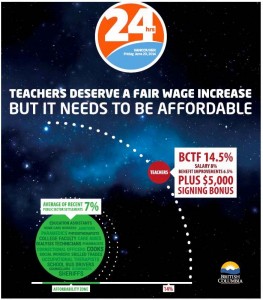Government Corrects Math, Needs Lesson on Communication
In an earlier post, I took a look at the math in an ad that the BC Government placed on the the front page of 24 Hours Vancouver. In the ad the government suggested that teachers were asking for an 8% increase in salary and a 6.5% increase in benefits for a total 14.5% increase. As I pointed out, you cannot add percentages and benefits that are typically closely related to salary.
What the government was not saying is that the 6.5% was not actually benefits. Rather, it was their assessment of what the costs would be to implement the BCTF proposal. The BC Public School Employers’ Association has publicly released their costing 0f the BCTF proposal. In addition, the BC government advertisement has revised their advertisement to eliminate the breakdown of the 14.5% into 8% salary and 6.5% benefits.
Initial Advertisement New Advertisement
Let’s take a close look at the government position. First, please let me reiterate. I am dismayed at the approach that seems to be occurring with respect to negotiation via press release and media statement. That is certainly not how I would expect respectful negotiations to proceed.
The BCPSEA costed summary table is reproduced below. In it, BCPSEA present their offer to the teachers and the BCTF demands of government. Most reasonable people would read this and wonder why the government’s position is an offer and the teachers’ position is a demand. It strikes me as an unfortunate choice of words that certainly does not aid in bringing parties together.
 So what’s actually in the teachers’ so-called compensation demands? Further inspection of the BCPSEA costing reveals the following:
So what’s actually in the teachers’ so-called compensation demands? Further inspection of the BCPSEA costing reveals the following:
Teachers’ Proposed Wage Increase
- July 1, 2014: 3.5% increase
- July 1, 2015: 1.5% increase
- July 1, 2016: 1.5% increase
- July 1, 2017: 1.5% increase
If a teacher’s current salary is T, then on July 1, 2017 it would be (assuming no change in seniority):
T × 1.035 × 1.015 × 1.015 × 1.015 = T × 1.082
That is, the teacher’s salary would increase by 8.2% (not 8%). Someone forgot to compound the increase in the original ad above while taking great care to use two significant figures to represent benefit increases.
And when you take closer look at the BCPSEA release they state this: Total Compensation is defined as all wages, wage-impacted benefits, and non- wage impacted benefits
It turns out that more than half of the “6.5% benefit improvements”, reported in the initial advertisement shown above, is to provide elementary school teachers with enhanced preparation time. This strikes me as a “working condition” not a “benefit” . Obviously I recognize that there are costs associated with improving working conditions, but to call this a”benefit” is a bit of a stretch.
Finally, I think it’s time for the government to pull back from attaching value added rhetoric and spin in its communication with the public about the ongoing negotiations with the BC teachers. Teaching is perhaps the most important profession in our society. After all, each and every one of us has attended school and that experience has shaped who we are, what we do and how we contribute to society. And let’s not hide behind the “it’s not affordable” mantra. Government is tasked with making choices. As I mentioned in another earlier post, education funding as a percentage of the provincial GDP has declined from a high of about 6.4% in 2001-2002 to an estimated low of about 5.0% in 2014-2015 (a decline of about 22%). If British Columbians deem education to be as important as I do, surely this drop needs to be rectified.
So are the BCTF and government really that far apart in terms of their positions? I think not. I am hopeful that with the timely appointment of a mediator, a negotiated settlement could be reached fairly quickly. But it’s important to put politics and historical differences aside. After all, our children are the next generation and it behoves us as a society to treat their education seriously.
Interview with Gregor Craigie – On The Island, CBC Radio, Victoria – June 24th, 2014







9 Comments
During the past 27 years that I was involved with teaching I have never seem any accurate costing statements from local bargainers for school districts, bcpsea, or the government of the day. It should be clear to all that the government is incapable of convincing the public that they are being beaten up by the BCTF. In fact it was the government who bullied teachers by insisting that the BCTF bargain their conditions of employment. The numbers demonstrate the governments handy cap, they can’t do percentages or proofread their own media material. The BC Liberals have the ability to spin tales and lie to the public, labour relations board, Supreme Court, and media outlets. The fact is that teachers care about the kids in their care and BCLiberals care about, well ask them? (pssst it’s the money). BCLiberals have consistently reduced education funding and made school boards the bad guys who cut staff and programs. There has been no fat to cut in your schools and yet the treasury board says cut some more. The supreme court has said class size and composition rights are constitutionally sound, arrogant minister fast-binder and premier clark don’t believe them. The BCLiberals negotiating stand is not wages but to claw back bargained rights protected by the the constitution. So regardless of the governments inability to do the math, or hire a professional to calculate such things, they stamp their little feet and refuse to accept they are wrong. Imagine a government who does not believe in the rule of law. anarchy is just across the bargaining table.
I would really like to see the numbers on what the government (taxpayers) have spent on the courts so far to fight the court cases create ads, pay salaries for the Christie Clark dream team in their battle to discredit the BCTF. They seem to have an unlimited budget when it comes to spin and CYA tactics but no money to pay to keep the system functioning.
I really appreciate this article and feel that is clarifies the issue and assesses the wage issue fairly. And on wages we are not far apart.
The issue that we are stuck on is class size and composition. Teachers are trying to address as well the short-changing of educational funding and the stripping of our contract (illegally, as said by 2 courts). The govt doesn’t want to address this at all or agree to address it after the upcoming court case. Instead they want a clause in our contract saying they can rip up our contract whenever they want and no longer have to adhere to the upcoming court ruling. Why should we ignore this? Wages are easy to compromise on – but what they do continually to affect the working conditions in my classroom and learning conditions for me students is huge? And why should they get to continue to ignore the courts? Who has them accountable? Who sets the example for our kids to value the law, the constitution, and to stand up for what’s right?
Trust me when I say no one wants a deal more than me. Teaching is not just my job, it’s who I am. Separating me from my students pains me. But I want them to know that they deserve the best education they can get. They’ve been short-changed for too long.
The B.C. Government (more accuratly Christy Clark ) is trying to break the union. It is high time we do something about it. Ms. Clark seems to forget that teachers and their friends and families are voters… she works for them, not the other way around.
Any advertisement that includes percentages but does not define what exactly the percentages are of should be considered misleading. There should be fine print with the breakdown somewhere one the ad. Using percentages is what you do to inflame those who already believe what you want them to. Make the number big and trust they won’t look into the way you got it. The advertisement read less like an attempt to educate the public about the teachers’ strike and more like a manipulative battle cry to recapture the support of the voters that put them there in the first place.
Andrew I do not understand your intentions when you write:
“If a teacher’s current salary is T, then on July 1, 2017 it would be (assuming no change in seniority):
T × 1.035 × 1.015 × 1.015 × 1.015 = T × 1.082
That is, the teacher’s salary would increase by 8.2% (not 8%). Someone forgot to compound the increase in the original ad above while taking great care to use two significant figures to represent benefit increases.”
Are you supporting teachers or trying to make them look like their demands are higher than the government is reporting? Because 8.2% + 6.5% is actually 14.7% which is clearly more than the advertised amount.
Besides, according to the Globe and Mail article:
http://www.theglobeandmail.com/news/british-columbia/what-you-need-to-know-about-labour-strife-between-bc-and-its-teachers/article19319472/
the interest is not compounded anyway so the 8% stands. 8.0% to be exact. Assuming The Globe is correct. But even if they aren’t, and the interest is compounded, then the government’s 7% spread over several years will be compounded to a slightly higher amount (although the calculation is more complex as the increments fluctuate in amounts and timing.) You should calculate this amount and show it. You appear to have the math skills to do it.
Hello Tom, the Globe and Mail said (8% not compounded) meaning that they recognized that they are just adding and not compounding. The settlement would be compounded. They could have written (8.2%, compounded).
The point I am making is that the original ad is sloppy and misleading.
@Tom – FYI, the compounding refers to a compounding salary, not interest. For example, say may salary is $100 this year. If I get a 10% raise each year for the next three years, my salary will be as follows:
Year 1 – $100 * 10% = $10 + $100 = $110
Year 2 – $110 * 10% = $11 + $110 = $121
Year 3 – $121 * 10% = $12.10 + $121 = $132.10 etc.
… and yes, I am a business education teacher. :)
Sorry, I meant compounding the increase, not interest. I’m sure my brain just slipped that in there as I am so used to seeing “compound” and “interest” together.
Can you impress me with calculating the true increase of the government’s proposed 7% increase? I’m actually serious, I want to see someone accurately do that.